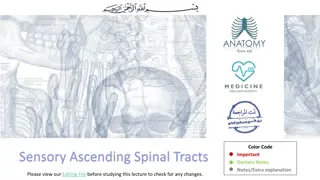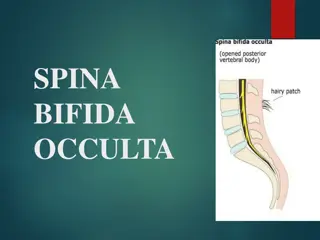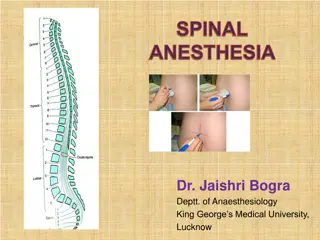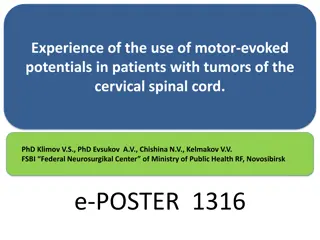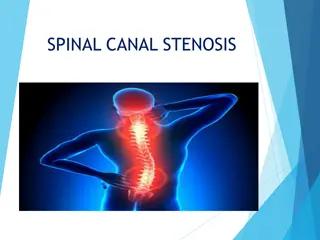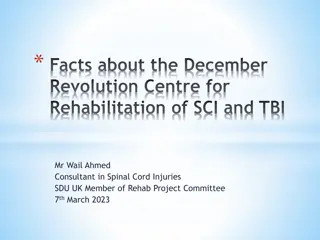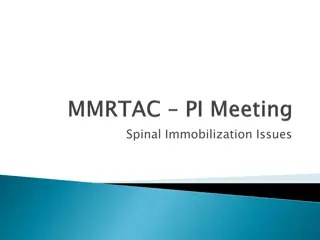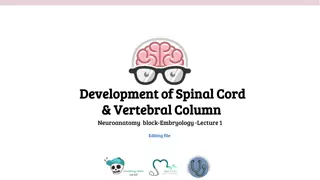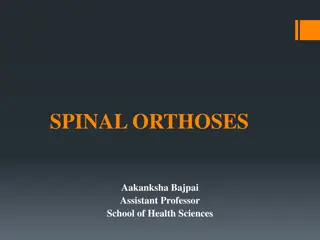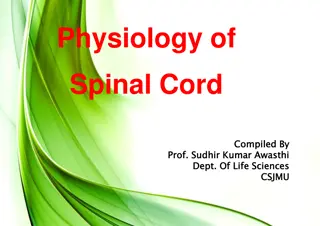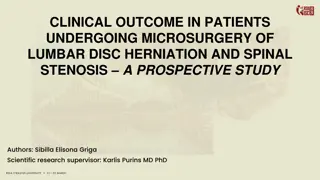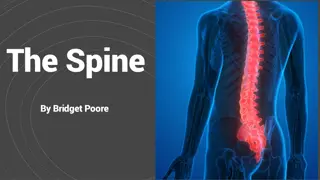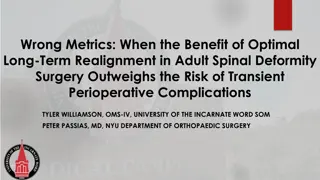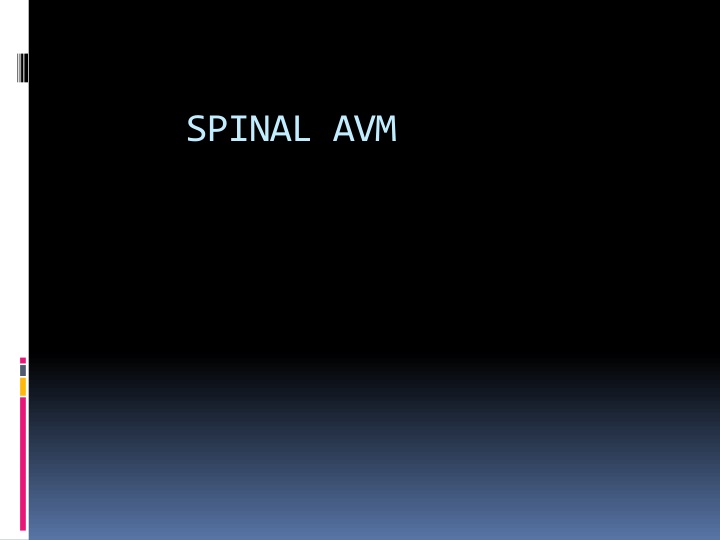
Spinal Arteriovenous Malformations (AVMs): An Overview
Explore the rare clinical entity of spinal cord vascular malformations, including historical perspectives, vascular anatomy, venous drainage, and classification by experts like Niimi and Berenstein and Anson and Spetzler. Learn about the distinct features, associated etiology, pathophysiology, and treatment options of spinal AVMs. Images included for better understanding.
Download Presentation

Please find below an Image/Link to download the presentation.
The content on the website is provided AS IS for your information and personal use only. It may not be sold, licensed, or shared on other websites without obtaining consent from the author. If you encounter any issues during the download, it is possible that the publisher has removed the file from their server.
You are allowed to download the files provided on this website for personal or commercial use, subject to the condition that they are used lawfully. All files are the property of their respective owners.
The content on the website is provided AS IS for your information and personal use only. It may not be sold, licensed, or shared on other websites without obtaining consent from the author.
E N D
Presentation Transcript
Introduction Vascular malformations of spinal cord are a rare clinical entity, representing 5% of all primary spinal cord lesions, with arteriovenous malformations(AVM) & cavernous malformations being the most common. They are relatively heterogeneous with distinct angiographic pattern and associated with specific etiology, pathophysiology, natural history and even a different therapy.
Historical perspective In 1888 -Gaupp :1stto describe a spinal dural AVM from a postmortem study. In 1910 Fedor Krausse :1stattempted to resect lesion . Sir charles elsberge : 1stsuccessful therapeutic operation for a spinal AVM in 1914 . 1926, Foix and Alajouanine reported the syndrome of subacute necrotic myelopathy associated with rapidly progressive onset of paraplegia and subsequent death. In 1960 with introduction of selective spinal angiography vascular anatomy of spinal AVMs became more clear .
Vascular anatomy Arterial anatomy (1) Medullary arteries Two arterial networks (a)Anterior (b) Posterior Both system supplied by medullary artery Upper thoracic watershed area (2) Radicular arteries-supplies dorsal / ventral nerve roots (3) Dural arteries dural root sleeves and spinal dura
Venous drainage Spinal cord drained by radial veins which carry blood from parenchyma to surface where they empty into the sulcal vein & coronal venous plexus in piamater on the cord and via medullary vein to epidural venous plexus .
Classification Niimi and Berenstein in 1999: a) Spinal vascular lesion spinal dural avf spinal extradural and paraspinal avf b) Spinal cord vascular lesion - AVF / AVM metameric / non metameric c) Spinal cord telangiectesias d) Cavernous vascular malformation Endovascuar treatment of spinal vascular malformation Neurosurg clin N Am 10:47 -71,1999
Classification Anson and Spetzler in 1992 Type I. Dural (intradural or extradural) AVF (also referred to as Type I spinal AVM or as angioma racemosum venosum, nidus, or true AVM) Type II. Glomus AVMs Type III. Juvenile AVMs (nidus usually intramedullary) Type IV. Direct spinal AVF Classification of spinal arteriovenous malformation and implication for treatments: BNI Q 8 :2-8 1992
YURI P. ZOZULYA, EUGENE I. SLIN KO, AND IYAD I. AL-QASHQISH, (2006) I. Intramedullary II. Intradural or perimedullary III. Dural IV. Epidural V. Intravertebral VI. Combined Spinal arteriovenous malformations: new classification and surgical treatment Yuri P. Zozulya, et al Neurosurgical FOCUS May 2006, Vol. 20, No. 5: 1-17.
Extradural AVF Rare vascular lesion Abnormal communication between an extradural radicular artery and epidural venous plexus. Progressive myelopathy / radiculopathy occasionally epidural hematoma Diagnosis- MRI / Angiography
Treatment Extradural AVF treated by endovascular treatment with embolisation of arterial feeder .
Intradural Dorsal AVF :type - 1 Between dural branch of radicular artery and intramedullary vein Clinical presentation Age middle age (40 60 year ) Male 90 % > female 10 % Site thoracic spine Progressive myelo-radiculopathy or cauda equina syndrome Aggravated by raised intra abdominal pressure Sub arachnoid haemorrhage rare Acute deterioration unlikely Two sub type Type -1a : single arterial feeder Type-1b : two or more arterial feeder Type I spinal AVM also known as spinal dural AVF Most common type AVF : 80 - 85 % Pathophysiology - slow flow fistula
Diagnosis MRI : the Perimedullary vein expansion look like serpiginous flow voids on the dorsal surface of the spinal cord, most often in the middle and lower thoracic spine. Spinal cord edema and thickening are typical
Angiographic studies Reveal expanded radiculomeningeal arteries, a vascular conglomerate in the region of the intervertebral neural foramen shunted into the expanded perimedullary veins. Nidus characterized by slow blood flow The blood flow in spinal cord arteries is also slower
Treatments Goal : isolation and obliteration of the fistula and draining veins. Best treated surgically: Direct surgical ligation of arterial feeder Low morbidity High success rate Embolization of the feeding vessel, via endovascular techniques Less invasive /same sitting /early rehabilitation
Dural AVMs Two variants of surgical technique 1) Occluding the malformation in the dural leaf of the spinal nerve root or cutting off the feeding vessels immediately outside the root. 2) occluding the radicular vein, which provides retrograde blood shunting from the AVM into the perimedullary veins.
Intradural Ventral AVF: type IV Rare lesion , not true AVM but instead Pial AVF First describe by Djindjian & coworker as Perimedullary AVF Heros & associates introduce term Type iv Direct fistula between ASA and draining vein Merland s Sub classification IV-A : smallest shunt , slow blood flow ,less venous hypertension IV- B : larger shunt , higher blood flow & greater degree hypertension IV-C giant : very high degree blood flow, with significant hypertension
Ventral intradural AVF: type:IV Clinical presentation Younger age Progressive myelopathy due to compression , venous hypertension or hematoma SAH and acute neurological deterioration Treatments IV-A:surgery IV-B:embolisation IV-C:combination of endovascular ablation, followed by surgical excision of retained elements.
Perimedullary AVMs Occlusion of the feeding vessels right at the nidus as the first step, then cut off the draining perimedullary veins & perform total resection of the AVM During this procedure, try to preserve the pial vascular plexus of the spinal cord.
Intramedullary AVM Also known as type 2 AVMS, glomus AVM, classic AVM, angioma racemosum arteriovenous. True AVM of spinal cord closely resemble to intracranial AVMS 15-20 % of all spinal AVM Male = female Age -earlier , 2nd or 3rd decade of life Associated with other vascular anomalies (13 % 37 % ) Site : uniforn distribution , cervical (30%) , thoracolumabar ( 70%) Clinical presentation - acute (35 % ) due to haemorrhage - progressive myelopathy (50 %) Two type 1) compact, 2) diffuse
Intramedullary AVM Type- II Diagnosis- MRI Hematomyelia /cord expansion /SAH Spinal angiography - Multiple feeding vessels from ASA & PSA -High pressure , relatively low resistance and high blood flow Managements (A) Embolisation followed by surgery (B) Radiosurgery for residual / non embolised lesion
Intramedullary glomus AVMs Two variants of nidus resection : 1) Isolate the vessels near the nidus and coagulate, then dissect the nidus and resect 2) The vessels are cut off in the nidus itself during its separation, and resection of the nidus.
Extradural Intradural: AVM Type-III Juvenile AVMs, Metameric AVMs Extremely rare lesion Complex lesion involving skin ,vertebra, and spinal cord Congenital lesion inborn errors of vascular embryogenesis Anatomically lesion feed by multiple enlarge medullary artery via anterior and posterolateral spinal artery and voluminous arteriovenous nidus that completely fills the thecal sac .Nidus has neural tissue within its interstices.
Clinical presentation Male = Female Onset earlier age Site uniform distribution along spinal axis Associated with other vascular anomalies Pain and progressive myelopathy related to compression and arterial steal
Treatment Primary extradural localization -endovascular technology Mainly intradural location and spinal cord compression -combination of endovascular and microsurgical methods
Conus AVMs Conus AVM are location specific and have feature of both AVMs & AVFs . They can be both perimedullary and intramedullary with diffuse border C/F : progressive myelo- radiculopathy & occasional SAH Spinal angiography s/o multiple arterial feeder , more then one nidus , and complex venous drainage Treatments combination of endovascular & surgical approach because of the possible pelvic disturbances, only performed occlusion of feeding vessels, leaving the malformation in situ.
Summary of treatments Occlusion of the feeding and draining vessels and malformation resection Intramedullary glomus AVM Perimedullary AVM Epidural AVM Combined AVM
Indications for occluding only the feeding vessels Dural AVM Intramedullary diffuse AVM Combined AVM Conus medullaris AVM
Combining surgical intervention with endovascular embolization High flow AVM and numerous large feeding vessels running into it After the endovascular embolization a mass effect due to AVM blood flow remains.
Embolic agents Particulate materials Poly vinyl alcohol(150-250micro) Gelfoam Sponge microparticulate Balloon occlusion Liquid agents N-butyl cyanoacrylate ethylene vinyl alcohol copolymer
Stereotactic radiosurgery Single high dose SRS 20 to 30% rate of occlusion. Hypofractionated irradiation Internal fiducial markers and image-guided radiation allow stereotactic irradiation for spinal disease with real-time verification and an accuracy of 1 mm for every 0.03 seconds Stereotactic Irradiation for Intramedullary AVMs Ten Years Experience Hokkaido University Collection of Scholarly and Academic Papers JAPAN




